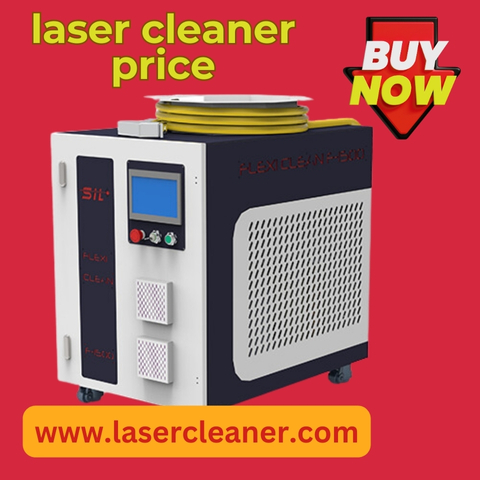
The industrial sector has witnessed a shift toward precision cleaning methods, and laser technology has become one of the most efficient innovations in this area. Among these, the laser cleaner has gained attention for its ability to remove rust, paint, grease, and oxide layers without the need for chemicals or abrasive materials. However, one of the most common questions asked by both small workshops and large factories is — what is the actual laser cleaner price and what factors define it?
This detailed guide explores every major aspect that influences the laser cleaner price, from technology and power levels to maintenance needs and long-term cost implications.
1. Introduction to Laser Cleaning Technology
Laser cleaning is based on the principle of laser ablation — a process where high-energy laser beams interact with the surface contaminants and vaporize them without damaging the base material. The process is non-contact, environmentally friendly, and highly precise.
Over the past decade, industries ranging from automotive and aerospace to restoration and electronics have started using laser cleaners to replace traditional sandblasting or chemical cleaning. This technological leap has naturally led to different price variations, depending on the intended application and required cleaning capacity.
When you research laser cleaner price, you’ll find that the cost range is broad — from compact handheld models to large automated systems. Understanding why such variations exist can help you make a smarter purchasing decision.
2. Factors That Influence Laser Cleaner Price
The laser cleaner price depends on multiple technical and operational factors. Below are the key elements that define how much you can expect to invest:
a. Laser Power Output
One of the most decisive elements affecting cost is power. Laser cleaners come in various wattage options — commonly from 100W to over 2000W.
-
Low-power units (100W–200W) are suitable for light surface cleaning, precision tasks, and delicate materials.
-
Mid-range systems (500W–1000W) handle moderate to heavy oxidation and rust.
-
High-power models (1500W–3000W) are designed for industrial-scale cleaning, often integrated into production lines.
As the power output increases, so does the price. More powerful lasers require stronger cooling systems, enhanced optics, and advanced control electronics, all contributing to higher cost.
b. Type of Laser Source
The laser source determines energy stability and beam quality. Fiber lasers are currently the most used due to their durability and efficiency.
-
Fiber laser cleaners typically cost more initially but have longer lifespans and require less maintenance.
-
CO₂ or solid-state lasers may have lower upfront costs but are less efficient for metal cleaning applications.
Therefore, the choice of source plays a major role in the laser cleaner price.
c. Automation and Control Features
Some laser cleaners are handheld, while others are fully automated with robotic arms or integrated CNC systems.
-
Handheld versions are flexible and cost-effective.
-
Automated systems, while expensive, provide consistent cleaning for repetitive industrial operations.
Customization and automation can significantly raise the final price tag but often improve long-term operational value.
d. Cooling System Type
Laser cleaning equipment generates heat during operation, requiring efficient cooling to maintain stable performance.
-
Air-cooled systems are compact and suitable for portable units.
-
Water-cooled systems are found in higher-power machines and cost more due to their complexity.
The type of cooling mechanism is an indirect but crucial factor in the laser cleaner price.
e. Brand and Manufacturing Standards
Global brands often price their machines higher due to quality assurance, safety certifications, and after-sales service. However, local or emerging manufacturers sometimes offer competitive rates for similar specifications. Evaluating warranty, spare parts availability, and support options is essential when comparing offers.
3. Price Range Overview
While prices vary by region and supplier, general pricing guidelines can be outlined:
-
Entry-level laser cleaners (100W–200W): approximately $4,000 – $8,000
-
Mid-range units (500W–1000W): approximately $10,000 – $25,000
-
High-end industrial systems (1500W–3000W): can exceed $40,000 or more
These are estimated figures, and the exact laser cleaner price depends on brand reputation, additional accessories, and customization needs.
4. Operational Costs and Long-Term Investment
The initial purchase price is only one part of the total investment. A comprehensive view includes operating costs such as electricity consumption, periodic maintenance, and replacement of optical components.
Laser cleaners are generally low-maintenance because they do not require consumables like sand or chemicals. Most systems are designed to operate for tens of thousands of hours with minimal servicing. Over time, this translates to significant cost savings compared to traditional cleaning methods.
Additionally, the precision and speed of laser cleaning reduce downtime and labor hours, further improving overall efficiency.
5. Industry Applications Affecting Price Selection
Different industries have unique cleaning requirements, which also influence the equipment selection and final laser cleaner price.
-
Automotive: Used for removing rust, paint, and coatings before welding or bonding.
-
Aerospace: Essential for cleaning turbine parts or metallic surfaces with high accuracy.
-
Manufacturing: Applied in mold cleaning, production line maintenance, and component restoration.
-
Cultural Heritage: Used in restoring monuments, sculptures, and artifacts without causing surface damage.
The intensity, frequency, and precision level required by these applications directly determine the power and model you need, ultimately influencing the investment.
6. Evaluating Supplier Offers
When comparing suppliers, look beyond just the listed laser cleaner price. Evaluate:
-
Warranty terms and service response time.
-
Quality of laser source (often the most expensive part).
-
Training and user support availability.
-
Software compatibility and ease of operation.
A slightly higher price from a reputable supplier can be more beneficial in the long run due to reliability and safety standards.
7. Future Trends in Laser Cleaner Pricing
As technology evolves, laser systems are becoming more accessible. Manufacturing costs for fiber optics and control units are gradually decreasing, which may make mid-range models more affordable in the coming years.
Additionally, the integration of smart monitoring systems and portable modular designs will influence pricing structures. The market trend suggests that while high-performance industrial units will maintain a premium cost, entry-level and mid-range devices will continue to drop in price as adoption increases.
8. Comparing Local and Imported Models
Local manufacturers often offer competitive pricing with customization flexibility, while imported units from established global brands ensure strict quality compliance and advanced performance.
Depending on your operational needs and budget, you can assess whether to invest in a top-tier imported machine or a cost-efficient locally produced model. Import taxes, shipping costs, and technical support should all be factored into the overall laser cleaner price.
9. Decision-Making Based on Application Scale
For small workshops or maintenance units, a 100W–200W handheld laser cleaner is usually sufficient and cost-effective. Large-scale manufacturing plants, on the other hand, require higher power and automation, which pushes the investment higher.
Before purchasing, define:
-
The type of materials you’ll be cleaning.
-
The expected cleaning depth and frequency.
-
The available working environment and power capacity.
Aligning these parameters helps you avoid overspending on unnecessary specifications.
10. Final Thoughts
Understanding the laser cleaner price requires looking beyond the sticker cost and focusing on what truly delivers value — performance, efficiency, and durability. Whether you choose a portable handheld cleaner for small jobs or a fully automated system for industrial operations, the key is to invest in a model that aligns with your cleaning needs and operational scale.
Laser cleaning represents a long-term technological shift toward sustainable, non-contact, and precise surface treatment. The right investment not only enhances cleaning quality but also ensures operational reliability and long-term cost efficiency.




